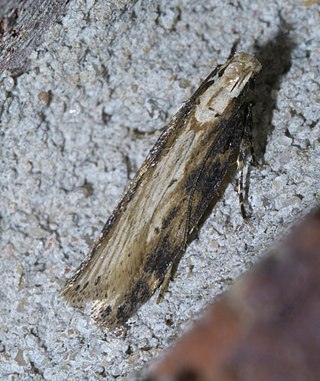
Chionodes distinctella, the eastern groundling, is a moth of the family Gelechiidae. It is found in almost all of Europe, as well as most of Russia, Kazakhstan, Central Asia and North Africa. The habitat consists of dry, rocky heath and meadows and the verges and rough pastures.

Chionodes fumatella, the downland groundling, is a moth of the family Gelechiidae. It is found in almost all of Europe. Outside of Europe, it is found in Turkey, the Caucasus, Mongolia and from Siberia to the Russian Far East.

Chionodes mediofuscella, the black-smudged chionodes moth, is a moth of the family Gelechiidae. It is found in North America, where it has been recorded from Nova Scotia to Florida and from British Columbia to Colorado, Arizona and northern California.
Chionodes arenella is a moth in the family Gelechiidae. It is found in North America, where it has been recorded from Nova Scotia to Virginia.

Chionodes hibiscella is a moth in the family Gelechiidae. It is found in North America, where it has been recorded from Connecticut and Illinois to South Carolina, Louisiana, Mississippi and Texas.
Chionodes metallica is a moth in the family Gelechiidae. It is found in North America, where it has been recorded from southern Alberta, Montana and Wyoming.

Chionodes obscurusella, the boxelder leafworm moth, is a moth in the family Gelechiidae. It is found in North America, where it has been recorded from Nova Scotia to Manitoba, south to North Carolina and Oklahoma.
Chionodes occidentella is a moth in the family Gelechiidae. It is found in North America, where it has been recorded from British Columbia to California and Arizona.
Chionodes ochreostrigella is a moth in the family Gelechiidae. It is found in North America, where it has been recorded from Alberta, Oregon, Arizona and California.
Chionodes phalacra is a moth in the family Gelechiidae. It is found in North America, where it has been recorded from Texas, Arizona and Mexico. It has also been recorded from Cuba.
Chionodes litigiosa is a moth in the family Gelechiidae. It is found in Ecuador.
Chionodes dryobathra is a moth in the family Gelechiidae. It is found in Colombia.
Chionodes pleroma is a moth in the family Gelechiidae. It is found in Mexico.
Chionodes concinna is a moth in the family Gelechiidae. It is found in Mexico (Guerrero).
Chionodes creberrima is a moth in the family Gelechiidae. It is found in Mexico (Guerrero).
Chionodes cacoderma is a moth in the family Gelechiidae. It is found in Mexico (Guerrero).
Chionodes neptica is a moth in the family Gelechiidae. It is found in Mexico (Guerrero).
Chionodes cerussata is a moth in the family Gelechiidae. It is found in Mexico.
Chionodes donatella is a moth in the family Gelechiidae. It is found in Florida, Jamaica and Cuba.
Chionodes salva is a moth in the family Gelechiidae. It is found in the West Indies.





